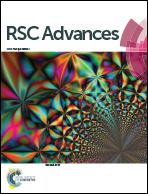Obvious modulation of rectifying performance by conjugation breaking of the bridging fragment in donor–bridge–acceptor molecular diodes†
Abstract
The rectifying properties of three donor–bridge–acceptor (D–B–A) type thiolated arylethynylene diodes designed by replacing one of the thiol anchoring groups to cyano, where the central bridging fragment is varied from cross-conjugated 9,10-anthraquinone (AQ), linearly-conjugated anthracene (AC) to broken-conjugated 9,10-dihydroanthracene (AH), are theoretically investigated using a non-equilibrium Green's function (NEGF) method combined with density functional theory (DFT). The numerical results reveal that both the rectifying performance and rectification direction of the D–B–A diodes are closely related with the conjugation type of the central bridging segment. The rectification performance is improved and the rectifying direction is inverted when the central bridge is changed from cross-conjugated AQ to linearly-conjugated AC. Moreover, when conjugation of the bridge part is broken, i.e., AH, the rectification performance is further enhanced remarkably. Further analysis reveals that the asymmetric evolution of strongly localized frontier molecular orbitals under positive and negative bias voltages, induced by conjugation breaking, is responsible for the great enhancement in rectification ratio for AH. This work is helpful for rational design of molecular diodes with diverse rectification performance.



 Please wait while we load your content...
Please wait while we load your content...